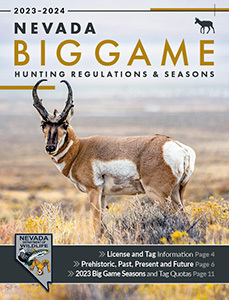2023 Big Game Notes Before Hunting
Limits and Hours
The limit is one animal per tag and the hunting hours are one-half hour before sunrise to one-half hour after sunset for all big game hunts, unless otherwise specified. New hunts, dates or units added to a hunt in 2023 are marked in blue.
PLEASE NOTE: Additional access may be available through private lands. Please visit the “Incentive and Compensation Maps” page on the NDOW website (ndow.org) for more information.
Helicopter Overflights and Your Hunt
Helicopter surveys may be conducted during hunting seasons. The monitoring flights are timed to occur during the most effective months of the year to check on important parameters including ratio of bucks to does, fawn recruitment, and calf production. While we try to avoid surveys during open hunting seasons, sometimes it cannot be avoided. We apologize for any disturbance this may cause and will make every effort to limit this activity during your hunt.
How Does The Draw System Work?
All applications, regardless of species or gender, are assigned a random number. Applications with bonus points are assigned additional random numbers by squaring the bonus point total and adding one for the current year (however only the lowest number within the bonus point application is used). Applications are drawn in sequential order starting with the lowest random number then evaluated within the following group order:
Group #1
Silver State, Partnership in Wildlife (PIW), and Junior Mule Deer
Group #2
Rocky Mountain Bighorn Sheep Ram, California Bighorn Sheep Ram, Nelson (Desert) Bighorn Sheep Ram, Elk Antlered, Elk Depredation Antlered, Antelope Horns Longer than Ears, Mule Deer Antlered, Mountain Goat, and Bear.
Group #3
California Bighorn Sheep Ewe, Nelson (Desert) bighorn Sheep Ewe, Elk Antlerless, Elk Depredation Antlerless, Antelope Horns Shorter than Ears, and Mule Deer Antlerless.
Group #4
Spike Elk, Management 1-Horn Ram
This allows applicants to put in for all species and gender classifications they wish to hunt, without worry of drawing a less preferred tag over a more preferred, due to changes in eligibility requirements (i.e. because you are now only allowed to draw a single tag for each species or subspecies category). For instance, in this draw order, if you draw an Antlered Elk tag early in the draw process, your application for Antlerless Elk will not be considered. However, you can apply for both Antlered and Antlerless Elk in the same draw and not worry about your Antlerless tag being drawn first before Antlered Elk.
Did you Know:
You can choose to be an alternate for a tag that is returned to NDOW. Select the alternate option during your application process for the potential to receive a tag after the main draw.
Big Game Hunt Survey
Hunt surveys must be submitted for all big game tags regardless of successful harvest. Questionnaires must be submitted on or before 5 p.m. PST on January 31 following the close of the hunt season for which the tag was issued. Hunts that close after January 31 must be submitted on or before 5 p.m. PST on February 28.
Hunt survey questionnaires may be submitted through a customer’s account at ndowlicensing.com by clicking the Surveys link.
Successful tag holders who fail to report a harvest return card will be subject to a $50 penalty and a suspension from the next season’s application period until the penalty is paid and the questionnaire completed. (Refer to NAC 502.405)
Physically Inspected Harvest
Successful bighorn sheep ram, mountain goat, and bear hunters that have their harvest physically inspected at a Department office will not be required to return a big game harvest questionnaire. Unsuccessful hunters for these species will still need to complete the hunter harvest questionnaire. Bighorn sheep ewe hunters are not required to have their harvest physically inspected at a Department office.
Minimum Legal Requirements For Taking Edible Meat From The Field
Hunters are encouraged to use as much of their harvest as possible. Although most meat from big game is edible, below are the minimum lawful requirements.
In the case of a big game mammal, except mountain lion and black bear, the meat of the front quarters as far as the distal joint of the radius-ulna (knee), hind quarters as far as the distal joint of the tibia-fibula (hock), and the meat along the backbone between the front and hind quarters.
- Front Quarter (Shoulder)
- Hind Quarter (Thigh)
- Backbone (Backstrap / Tenderloin)


